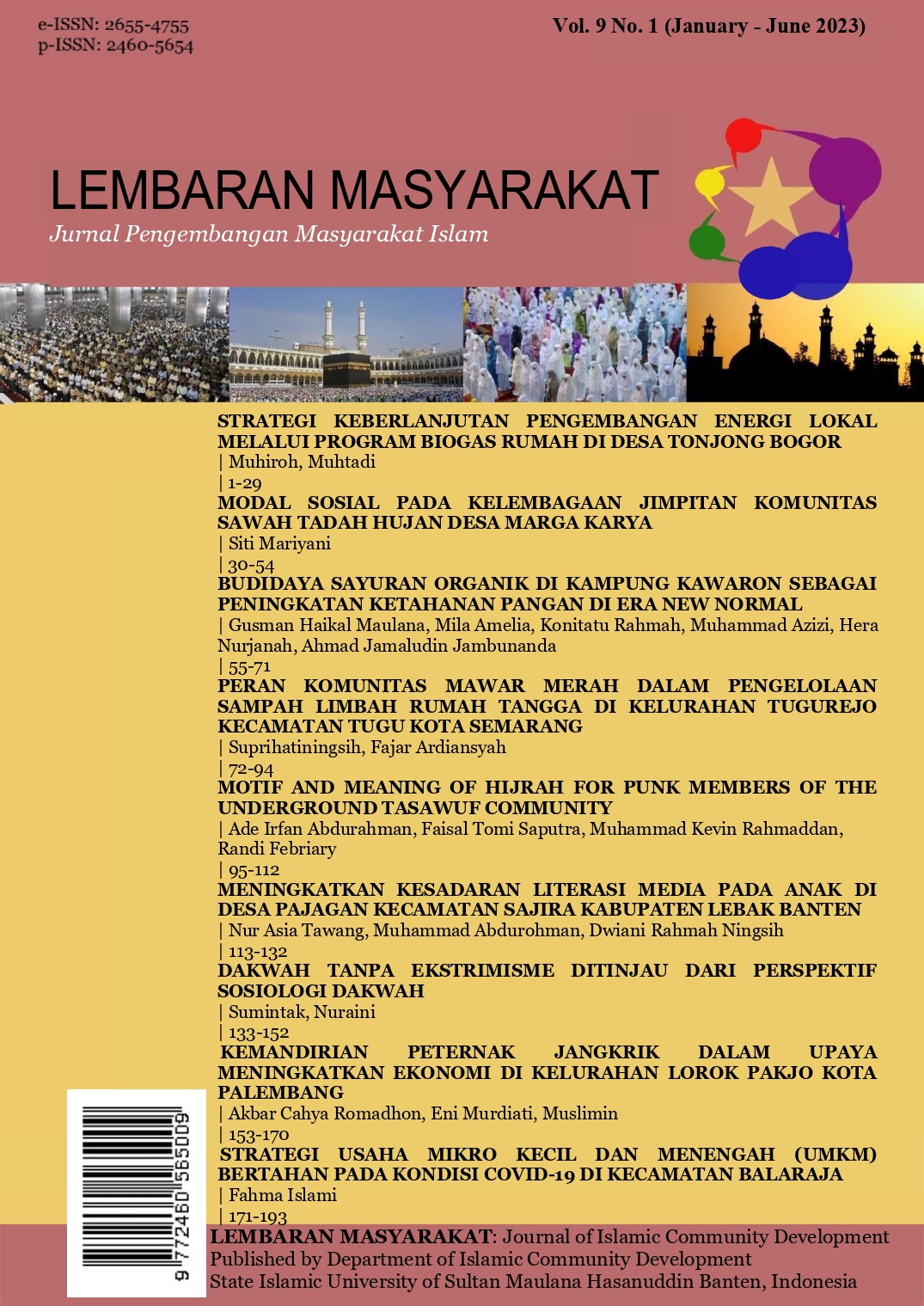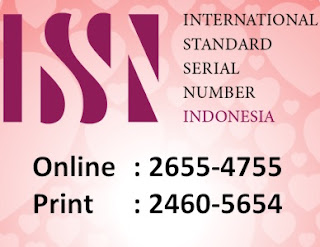MOTIF AND MEANING OF HIJRAH FOR PUNK MEMBERS OF THE UNDERGROUND TASAWUF COMMUNITY
DOI:
https://doi.org/10.32678/lbrmasy.v9i1.8575Keywords:
Phenomenology, Punk, Hijrah, Tasawuf UndergroundAbstract
This research is motivated by the phenomenon of hijrah in marginal communities, especially the underground Sufism community. This community is very concerned about the fate of Punk children around Jabodetabek. On this basis, the researcher was moved to conduct research on the meaning of 'hijrah' for the Punk children of the Underground Tasawuf Community. This research uses the phenomenological method in examining the theme of this discussion. The results of this study indicate that there are two motives for hijrah, first; awareness for wrong behavior and family motives. Meanwhile, hijrah means moving to the sea of knowledge, changing attitudes and improving the quality of worship, cleaning up from heart disease, forgiving and being devoted to parents.
Downloads
References
Abdurahman, Ade Irfan, and Faisal Tomi Saputra. 2021. “Communication Strategy of Tasawuf Underground Community in Da’wah Towards Punk Community.” KOMUNIKA: Jurnal Dakwah Dan Komunikasi 15(2):173–90. doi: 10.24090/komunika.v15i2.4595.
Dawson, Lorne L., and Amarnath Amarasingam. 2017. “Studies in Conflict & Terrorism Talking to Foreign Fighters : Insights into the Motivations for Hijrah to Syria and Iraq.”Studies In Conflict & Terrorism 40(3):191–210. doi: 10.1080/1057610X.2016.1274216.
Farhan, Ahmad. 2020. “Narasi Hijrah: Sebuah Fenomena Living Qur’an Pada Komunitas Biker Muslim Bengkulu.” El-Afkar: Jurnal Pemikiran Keislaman Dan Tafsir Hadis 9(1):166–83.
Gunawan, Iwan. 2022. “Relasi Hijrah Dan Taubat Persfektif Muhammad Hasbi Ash-Shiddieqy Dalam Tafsir Al-Qur’anul Majid An-Nuur.” Tanzil: Jurnal Studi Al-Qur’an 5(1):1–44.
Hariyani, Agnes Dwi. 2021. “Makna Hijrah Dan Dimensi Keberagamaan Mahasiswa Lembaga Dakwah Kampus Di Fakultas Ilmu Sosial Dan Ilmu Politik Universitas Mulawarman.” Sosiatri-Sosiologi 9(2):15–29.
Hasbiansyah, O. 2008. “Pendekatan Fenomenologi: Pengantar Praktik Penelitian Dalam Ilmu Sosial Dan Komunikasi.” Mediator: Jurnal Komunikasi 9(1):163–80. doi: 10.29313/mediator.v9i1.1146.
Hastjarjo, Dicky. 2015. “Sekilas Tentang Kesadaran (Consciousness).” Jurnal Buletin Psikologi 13(2):79–90.
Iskandar, Doni, and M. Jacky. 2015. “Studi Fenomenologi Motif Anggota Satuan Resimen Mahasiswa 804 Universitas Negeri Surabaya.” Jurnal Ilmu Sosial Universitas Negeri Surabaya 3(1):1–12.
Isnan, Ansory. 2020. Hijrah Dalam Perspektif Fiqih Islam. Rumah Fiqih Publishing Jalan.
Karim, Hamdi Abdul. 2021. “Potret Kehidupan Komunitas Punk (Studi Kasus Anak Punk Di Lapangan Samber Kota Metro).” Jurnal Bimbingan Penyuluhan Islam 02(01):1–14.
KBBI Online. 2023. “Kamus Besar Bahasa Indonesia (KBBI) Kamus Versi Online/Daring (Dalam Jaringan).” Retrieved June 15, 2023 (https://kbbi.web.id).
Kuswarno, Engkus. (2013). Fenonomenologi: Konsepsi, Pedoman, dan Contoh Penelitiannya. Cetakan Kedua. Bandung: Widya Padjajaran
Lestari, Intan Dwi, and Yun Fitrahyati Laturrakhmi. 2021. “Studi Fenomenologi Tentang Motif Dan Aturan Pertemanan Virtual Di Kalangan Pengguna Twitter.” Jurnal Manajemen Komunikasi 5(2):195. doi: 10.24198/jmk.v5i2.29290.
Littlejohn, Stephen W. (2002).Theories of Human Communication.Seven Edition. USA: Wadsworth
Mahdi. NK. 2018. “Komunitas Punk; Sebab, Akibat Dan Metode Pembinaan Dalam Perpektif Islam.” At Taujih Bimbingab Dan Konseling Islam 1(1):84–101.
Putra Nugraha, Januar, and Pambudi Handoyo. n.d. “Punk Dan Keluarga : Studi Fenomenologi Motif Menjadi Punkers Dalam Lingkup Keluarga.” 1–7.
Zahara, Mila Nabila, Dadan Wildan, and Siti Komariah. 2020. “Gerakan Hijrah: Pencarian Identitas Untuk Muslim Milenial Di Era Digital.” Indonesian Journal of Sociology, Education, and Development 2(1):52–65. doi: 10.52483/ijsed.v2i1.21.
Downloads
Published
Issue
Section
License
Copyright (c) 2023 Lembaran Masyarakat: Jurnal Pengembangan Masyarakat Islam

This work is licensed under a Creative Commons Attribution-NonCommercial 4.0 International License.









.png)
.png)
.png)

.png)











